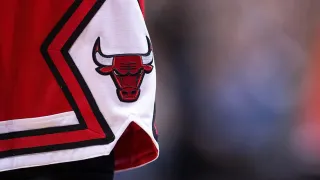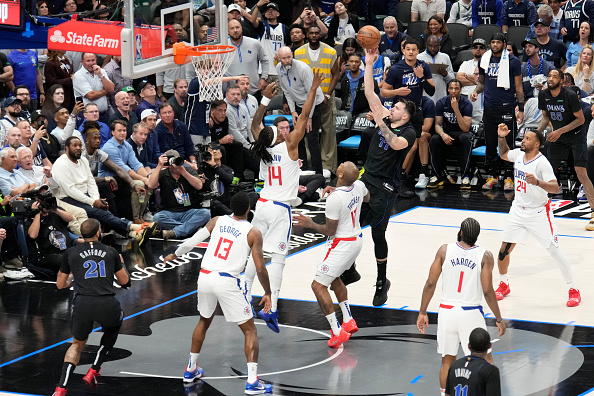
In an interview on the Mully & Haugh Show on 670 The Score Monday morning, Artūras Karnišovas reiterated his belief in the Bulls’ core in the wake of Jim Boylen’s firing.
“The great thing is when I came and took the job, actually, I went through the roster, and I liked what I saw,” Karnišovas said on the show. “I feel that the core of this team is great. By adding another pick and, you know, we’re going to look at free agency and we’re going to have one or two other players, I think it’s a good situation right now we’re in.”
Most prognosticators would agree that the Bulls’ roster features some intriguing young talent — chiefly, the foursome of Zach LaVine, Lauri Markkanen, Wendell Carter Jr. and Coby White. LaVine is coming off a career year, and the latter three were selected with the No. 7 picks in the last three drafts.
Stay in the game with the latest updates on your beloved Chicago sports teams! Sign up here for our All Access Daily newsletter.
While the Bulls’ rebuild hit its fair share of snags this season, the optimistic view is that fresh front office management, a new coach, and tweaked offensive and defensive systems will amplify those four and the pieces around them. Carter and Markkanen, specifically, saw their development stagnant and usage fluctuate under Boylen in 2019-20.
It behooves Karnišovas to speak glowingly of the team, especially as he searches for that new coach. But this is still a roster that won 22 of its 65 contests this season. And whenever the NBA kicks off the 2020-21 campaign, it will likely look largely the same.
Assuming Otto Porter Jr. opts into his near-$28.5 million player option, and the Bulls both select and sign a player with their first-round pick in the 2020 draft, Karnišovas will enter his first offseason as executive vice president at the helm of an over-the-cap team.
Here’s a rough breakdown of the 13 players either already or presumably under contract. Figures courtesy of Spotrac:
NBA
| Player | 2020-21 Cap Figure |
Otto Porter Jr. | $28,489,238 |
Zach LaVine | $19,500,000 |
Thad Young | $13,545,000 |
Tomas Satoransky | $10,000,000 |
Cristiano Felicio | $7,529,020 |
Lauri Markkanen | $6,731,508 |
Coby White | $5,572,680 |
Wendell Carter Jr. | $5,448,840 |
Ryan Arcidiacono | $3,000,000 |
Chandler Hutchison | $2,443,440 |
Luke Kornet | $2,250,000 |
Daniel Gafford | $1,517,000 |
[No. 7 Pick] | $5,572,680** |
TOTAL | $111,600,387 |
* = Player option (deadline Oct. 17)
** = Using cap allotment for pick No. 7 from 2019 draft. The implications of the COVID-19 pandemic on the current CBA are yet to be determined — or, at least, announced/leaked
Even before potentially negotiating restricted free agents Kris Dunn, Denzel Valentine and Shaq Harrison, or signing their second-round pick (No. 44), the above salaries take the Bulls a hair over the $109.1 million 2019-20 salary cap line entering this year's free agency (until the implications on the COVID-19 pandemic are known, 2019-20 is the only reference point with which to work). Bringing back Dunn, Valentine or Harrison, or adding that second-rounder to the roster would take them further into the red.
So, there’ll be no big splash this offseason. In a world full of uncertainty, that much seems set in stone.
Other than foster improvements from the players under contract, what is there to tinker with? Where do those "one or two" free agent additions Karnišovas alluded to come from?
As an over-the-cap — but presumably under the luxury tax ($132.6 million in 2019) — club, the Bulls will have two exceptions at their disposal to bring in players via free agency: the non-taxpayer mid-level exception and the bi-annual exception, the latter of which is available to teams only on an every-other-year basis.
(For the purposes of this article, we’ll also proceed under the assumption that each exception’s value holds in the vicinity of where it was set during the 2019 offseason — $9.3 million for the non-taxpayer mid-level, and $3.6 million for the bi-annual. Again, exact salary cap figures are pending.)
Last offseason, the Bulls didn’t own either exception, as the team dipped under the salary cap line to sign Thad Young and Tomáš Satoranský. MLE and BAE privileges are for over-the-cap teams only and are wiped once a team goes under the salary cap line. The Bulls used part of their room exception (which replaces the mid-level for teams that go under the cap line, then back above it) to ink Luke Kornet to his current two-year deal.
But this year, Karnisovas and Co. will have the opportunity to get creative with their exceptions. The MLE or BAE allocations can be either used on one player or split between multiple; in 2019, for example, the Golden State Warriors divided their mid-level between seven guys.
The Bulls won’t have near that level of flexibility. Depending on decisions on aforementioned restricted free agents, the roster could have up to two open spots when free agency begins — though waiving, say, Cristiano Felício, or trading Young or Satoranský could free up more.
Regardless, the new front office might be best served going all-in on their MLE — mid-level contracts can run up to four years, but the Bulls would likely eye a short-term pact to keep maintain long-term maneuverability — and using their remaining spot(s) on their second-rounder, or possibly some combination of Dunn, Valentine or Harrison.
Which area should they allocate that resource? With the oft-injured Otto Porter Jr. and Chandler Hutchison the only traditional small forwards on the roster, wing depth represents a glaring need. For a team that ranked 11th in the NBA in 3-point attempts per game (35.1), but just 22nd in 3-point field goal percentage (34.8%), perimeter shooting does too.
Our K.C. Johnson pinpointed a few preliminary names to keep an eye on in his latest mailbag:
All would help this team, and all will be unrestricted free agents with the exception of Matthews, who owns a player option for $2.7 million with the Milwaukee Bucks.
Kentavious Caldwell-Pope and Stanley Johnson are all also unrestricted and could make an impact in the right role on the wing. Langston Galloway, E’Twaun Moore and Justin Holiday fit the bill (and price) of sharp-shooting reserve guard options. If the Bulls trade Young, JaMychal Green could make sense as a stretchy reserve big.
These are just some ideas. The team’s impending top-10 pick should contribute next year, too, as might their second-round choice if new management finds a diamond in the late-pick rough.
Make no mistake: Internal improvement is the best way for the Bulls to kick their rebuild out of neutral in 2020-21. And the hope is a player-development-focused coach will be key to unlocking that. The free agency period of 2021, when the Bulls are projected to have significant cap space and a litany of stars are expected to be available, is when real roster shakeup might occur.
But the resource cupboard isn’t totally bare for the team. And there’s nowhere to go but up.


